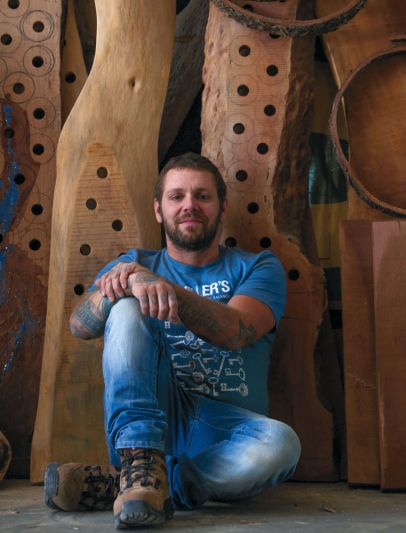Lumber of Love
When 150-year-old hickory from a tobacco barn finds its way into the 390 Design workshop, Mark Nodeen gets meditative. His aesthetic eye can see the slab’s future start to unfold, and he envisions the potential beauty in the beat-up lumber. Concepts for dining tables, bars, benches, consoles, and shelves float through the Sarasota woodworker’s creative brain until a one-of-a-kind piece of furniture is ultimately crafted.
“Every time I see a piece of wood with a really great backstory, I can’t wait to work with it. I get inspired just knowing I can breathe life back into something that otherwise might have been collecting dust somewhere,” says Nodeen, a self-taught entrepreneur who has built furniture for locales across the map, from Whole Foods Market locations throughout Florida to upscale restaurants and celebrity residences.
His medium might be heart pine, walnut, redwood, pecky cypress, oak, ash, poplar, mahogany, or maple. His sources range from exotic mills (which carry high-end lumber) to deconstructors (who sell remnants of torn-down buildings) to pickers (who cart back truckloads of wood from their cross-country treks) to resellers (who salvage pieces from local historical structures). The gems come to Nodeen in the form of floorboards, hand-hewn beams, joists, paneling, and window frames. He has turned St. Petersburg High School basketball gym flooring into barn doors and consoles, and paint-chipped beadboard from the Belleview-Biltmore Hotel into dining tables.
“It means a lot to customers and restaurants when they hear that the wood I’ve used came from somewhere or something sentimental to them,” Nodeen says. “Maybe I made them a table from the floorboards of their old high school gym. It’s like I’ve rescued a piece of their past and now they get to keep it in their home. What would have happened to that flooring if I hadn’t reused it? I’m glad it didn’t end up in a landfill somewhere.”
The shift toward a sustainable, eco-conscious culture has served Nodeen well, as the demand for reclaimed wood furniture keeps his workshop jammed with projects and his waiting list long. The dusty 390 Design warehouse, packed with high-end power sanders and saws, has racks of wood soon to be transformed into sturdily built heirlooms that will outlive Nodeen.
“I’m lucky to do the kind of work that gets me excited every day. I’ve always been an artistic person but there’s something about working with wood (especially antique wood) that really inspires me,” Nodeen says. “It makes me happy to know that people will enjoy a meal at an amazing table, and that generations of people will get to have those experiences because of the work I’ve done. It’s functional art, it’s good for the environment, and it’s made by hand and with a lot of love.”
For more information on 390 Design, visit instagram.com/390design or email 390design@gmail.com.





